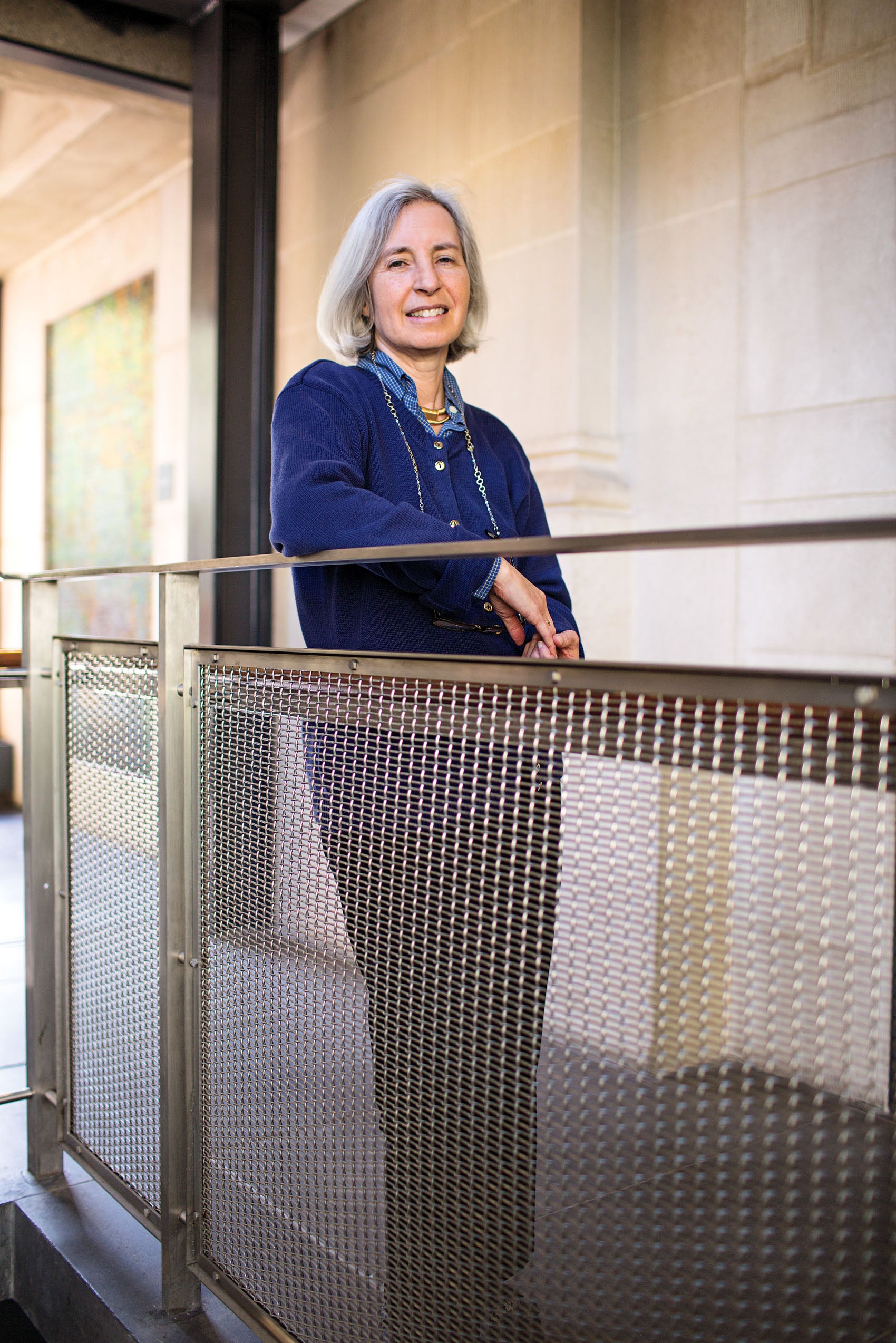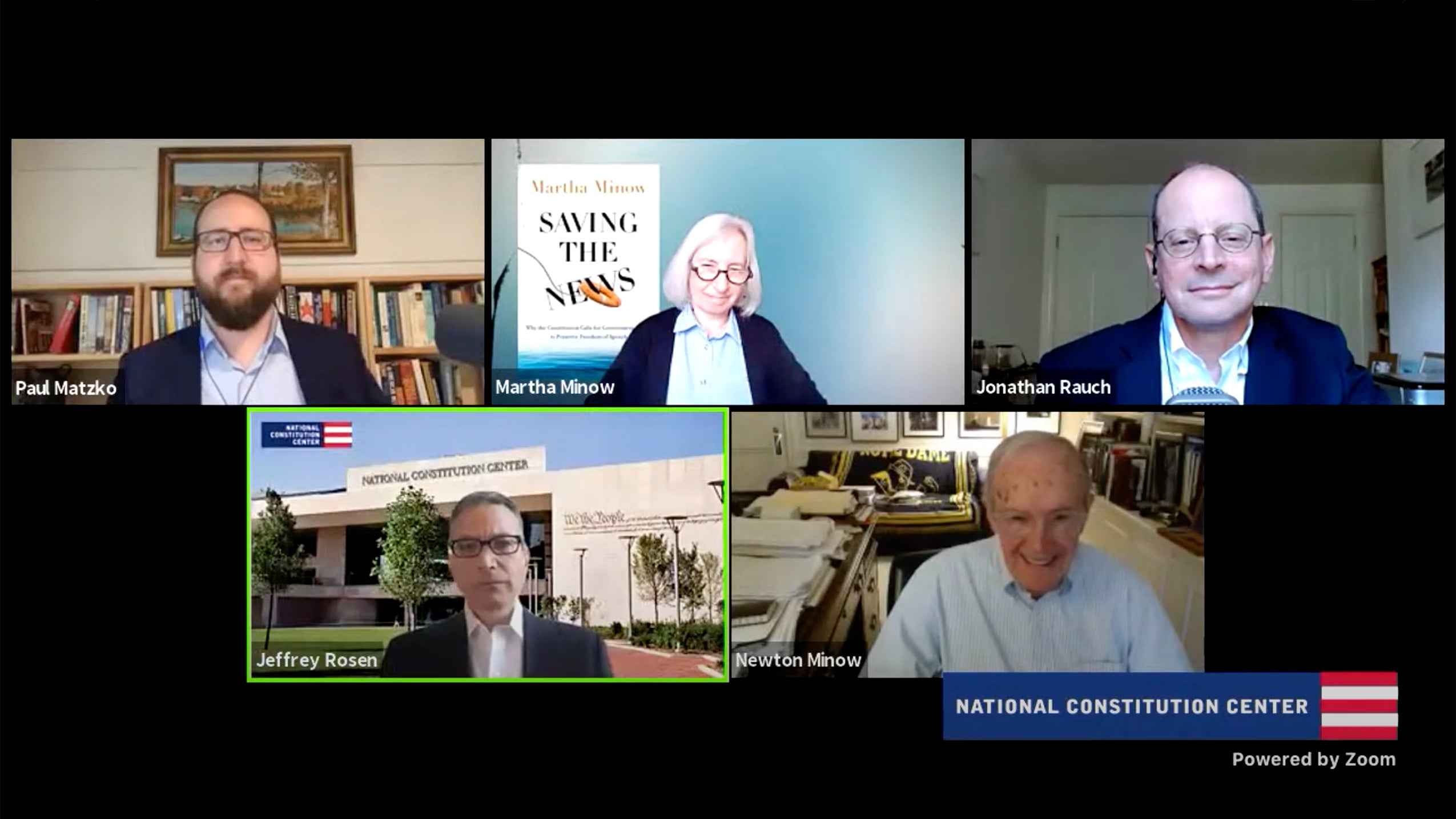“We are living in an unprecedented time, with more information available at people’s fingertips than any time in history, but also with the cacophony and confusion that follows,” said Martha Minow, 300th Anniversary University Professor at Harvard University and former dean of Harvard Law School, during a discussion held by the National Constitution Center on June 15. Without intervention, she argued, “we’re on a collision course with sanity.”
Minow, who is also the author of the forthcoming book “Saving the News: Why the Constitution Calls for Government Action to Preserve Freedom of Speech,” was joined at the event, titled “Free Speech, Media, Truth and Lies,” by Paul Matzko of the Cato Institute and Jonathan Rauch, author of the new book “The Constitution of Knowledge: A Defense of Truth.” Panelists discussed balancing free speech and regulation in an era of disinformation and ubiquitous social and new media outlets.
“Only one private industry is mentioned in the Constitution, and that is the press,” said Minow, adding that she believes that was no accident: “The framers understood how central the press was and is to the maintenance of a constitutional democracy.”
Social media — and other types of new media — often rely on advertising as their business model and are thus incentivized to show users outrageous content to encourage their engagement, Minow said. They also often repackage and display news generated by more traditional outlets without compensation. This “draws away from conventional media the heart blood of the financial mechanism that supported” more traditional media, said Minow.
And not only have these new media helped decimate local and national news outlets, but they have also led to the “blurring of reportage and opinion” — and the dissemination of inaccurate or even false news, she added.
To combat this, Minow suggested a return to the view of the First Amendment not as a barrier to regulation but as an active organizer of the marketplace to ensure a “rich and vibrant ecosystem of news.” In particular, she recommended addressing the economic factors undermining traditional news’ profitability, by taxing internet companies and enforcing intellectual property laws against them to “require payment for the circulation of material developed by others.”
Minow said that she believed there could even be a new Fairness Doctrine — a policy originally adopted by the Federal Communications Commission in 1949 to require broadcasters to present both sides of controversial issues — under which these new “platforms … are not censors, but instead sharers of varieties of viewpoints in news.”

Beyond the internet and social media companies themselves, Minow also advocated for a “public internet,” which would support a variety of neutral, nonpartisan public interest outlets to “improve the marketplace of competition.”
Matzko was wary of some of Minow’s reforms. “Few things send a shudder down my spine quite like hearing we should apply a public interest standard,” he said, adding that, “This idea that there a singular public interest that can be identified by a group of technocrats, lawyers sitting in a room in Washington, D.C., has done a lot of really anti-progressive harm.”
That includes the Fairness Doctrine, which, before the FCC eliminated the policy in 1987, Matzko argued had been used by authorities of both parties to censor and control speech it deemed radical or even merely antithetical to their interests.
President John F. Kennedy, for example, “weaponized” the Fairness Doctrine to attack those who were against his legislative agenda, such as the Nuclear Test Ban Treaty, said Matzko. Because radio stations had to broadcast both sides of an argument, even if the other side could not pay for air time, there was a “chilling effect,” and stations “dropped right-wing radio en masse” to avoid the issue, he said.
But Rauch agreed with Minow’s diagnosis. “We had all hoped, when the internet came along, that it would be a vibrant marketplace of ideas where truth would prevail. … What we forgot is that the marketplace of ideas depends on a structure.” What we got instead, he said, “was a race to the bottom.”
For Rauch, there were two distinct problems with the current information ecosystem: a “hostility to truth” and the embrace of misinformation on the internet, and what Minow identified as “the collapse of the business model for reality-based journalism.”
But Rauch thought that the first issue — what he referred to as the “epistemic problem” — “is very hard for the government to deal with,” and he disagreed with the idea that it should try to do so directly.
Instead, in Rauch’s view, those inside and outside the industry should encourage the development of consistent and transparent standards and ethics codes for the internet. This self-regulation would mirror the professionalization of newspapers that occurred between the end of the 19th century and the mid-20th century, when reporting went from sensational “yellow journalism” to an editorial process that includes fact-checkers and multiple levels of review.
“I think we’re seeing the beginning of a similar process in the world of Facebook and maybe even Twitter,” he said. “I think the real magic in the long run is not going to be in policy design. … It’s going to be product design” to make platforms “less friendly to misinformation.”
Minow conceded that while the Fairness Doctrine had sometimes been abused, she asserted that that was an issue with implementation, not a flaw in the policy itself. She added that the original Fairness Doctrine was justified on the basis of scarcity — of the electromagnetic spectrum on which radio and television used to be broadcast, in particular — but that today’s media results in “attention scarcity,” where “everyone is speaking at once in a different way,” she said.
She also agreed with Rauch that there were two distinct problems — the problem of fake news and the lack of viability of traditional news — but said both resulted from what she called “cognitive disruption.”
“The biggest … platforms are giving full employment to cognitive psychologists … who are paid … to find ways to exploit our confusion and our vulnerabilities to find ways to keep us engaged” using algorithms that display more and more extreme opinions and information, she said.
In this area, “the government has obligations” to “guard us from exploitation,” said Minow, and in particular, to foster competition in the marketplace by bolstering public interest news sources.
The marketplace of idea should better mirror the actual economic marketplace, which has rules, regulations, and guardrails to foster competition and build trust among participants, she asserted. “If there is one takeaway from my argument … it’s that the Constitution permits and may even require the creation and reinforcement of the structuring of the market for information.”
Yet, according to Minow, the courts, which have until recently had been “vindicators of the First Amendment values” are “now becoming barriers by using a weaponized First Amendment to strike down the very rules that make the marketplace possible.”
She urged the courts and other branches of government to step up and protect Americans from what she sees as a crisis of disinformation — by enforcing existing laws and by enacting new ones aimed at fostering a fairer and healthier news ecosystem.
“The First Amendment should not be a barrier to sane regulation and indeed to equipping ordinary people … to monitor what we’re being fed,” Minow said.
